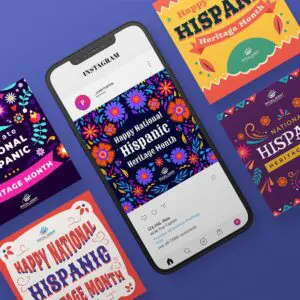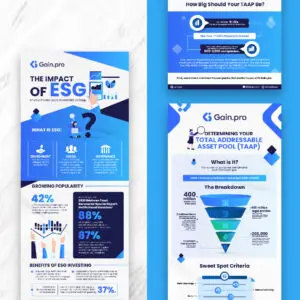![How to Measure Customer Engagement [Free Formulas]](https://penji.co/wp-content/uploads/2023/08/How-to-Measure-Customer-Engagement-3-01-scaled-e1694114806542.jpg)
Customer engagement is wildly important to your success as a business owner. But measuring it isn’t always cut and dry. Beyond vanity metrics, there are ways to measure engagement that provide real insight into your progress as a company. In this article, we’ll go over how to measure customer engagement in a way that scratches beneath the surface.
How to Measure Customer Engagement

Customers and potential customers are engaging with your brand across platforms. Website, social channels, landing pages, apps, and in-person events are just some of the ways people get to know and love your brand.
Fortunately, you don’t have to be a math wizard to gather data and analyze the results. Nowadays, this is largely done for you by whatever platforms you use. All you need to do is schedule regular reviews during which you can analyze all data from all platforms.
You’ll find vital customer engagement data through:
- email platforms
- CRM software
- social channels
- Google analytics
- marketing software
- and more
It’s worth noting that heat maps can give key insight into the customer journey. If your main goal is to optimize your website for more conversions, heatmapping software can be a gamechanger. It can reveal where your customers are getting lost, confused, or frustrated during the checkout process (or while browsing your website in general).
The Most Important Customer Engagement Metrics to Track
You can’t measure anything without the right metrics and accurate data. The following metrics will help you get a birds-eye view of how your customers are engaging (or not engaging) with your brand. From there, you’ll be able to make powerful changes that improve brand awareness, loyalty, and sales over time.
Bounce Rate

A website’s high bounce rate is often the first indicator of disengagement. Though your visitors may not be customers yet, they are well on their way if your website is engaging. Thus bounce rates are an important problem to solve ASAP. Think of bounce rates as the ‘entrypoint metric’ – They mark the beginning of your relationship with a new visitor.
How to Track Bounce Rates
When someone visits your website and leaves without navigating to any other pages, that’s considered a bounce. Google Analytics is a simple way to track your website or store’s bounce rate. Take the number of single-page sessions and divide it by the number of all sessions.
Churn
Some amount of churn is inevitable, but how much is too much? Some sources say 3-5% is typical while others say under 8% is acceptable. Norms vary by industry, and of course, you don’t just want to be average. You want the lowest churn rate possible for your business.
How to Calculate Churn
Churn rates are highly relevant to companies that operate on a subscription model such as SaaS providers.
Calculating your churn rate is simple: Take the number of customers lost divided by the total number of customers in a given timeframe (eg. a month or a year).
Customer Satisfaction
How to measure customer satisfaction? The most common way is 1-5 star reviews. They’re easy to understand, customers can add additional comments, and those who are new to your brand can read through them. You might also employ customer surveys, though they require more effort from the customer.
One widely-used survey is the Net Promoter Score (NPS), which separates customers into those who would recommend your brand and those who wouldn’t. You can then calculate the ratio of ‘promoters’ to ‘detractors.’ The potential downside to this survey is that a customer could simply have no one to recommend your services to (eg. If you serve business owners but your customer doesn’t know any other business owners, they might respond to your survey less enthusiastically, giving the false impression that they are dissatisfied).
Email Open Rates
Emails are yet another opportunity to provide something valuable and spark audience interest. But it’s a full-time job in itself to consistently write engaging emails that lead your reader to the appropriate call to action. This is where email segmentation comes in handy.
How to Track Email Open Rates
Fortunately, email platforms like Mailchimp and Constant Contact will do this for you. Simply check the stats for every sent email to see the individual open rates. You can add all your open rates for the month together and get an average. This will help you see what type of emails your audience responds to.
Social Media Engagement

Likes, shares, comments, views – It has long been warned that these ‘vanity metrics’ shouldn’t be relied upon to gauge success in business. And this is true. None of them translate directly to sales. However, it can still make a world of difference when social engagement is high. Why?
- Social proof – When potential customers see high engagement on your account, it automatically instills greater trust in your brand. If instead they’re hearing crickets on your profile page, it sparks suspicion.
- Greater reach – Social media algorithms dictate that the more engagement you get, the greater your reach. So if you want to reach a wider audience, getting post engagement is key.
Review your social media metrics in the stats section of each platform and you’ll start to see patterns emerge. Your audience might prefer videos to text, or they might enjoy certain topics you cover over others. Find those threads of success and double down on that type of content.
Conversions
Clearly the most important customer engagement metric, conversions show whether you are hitting your revenue goals or not.
How to Calculate Conversion Rate
Divide the number of total conversions by the number of total interactions. So if a social media ad gets 1200 views and 2 people click through and make a purchase, your conversion rate is .16%. For email, you’d take the number of sales and divide by the number of email views.
Word of Mouth
It might seem difficult to track word of mouth as it’s not the most specific metric. But thanks to the advent of social listening tools, you can get a good idea of what people think of your brand.
As you track what is being said online, stay alert for patterns. If some or most of your customers are complaining about the same issues, those are the most critical things to fix. If you notice a lot of people are praising your brand for the same benefit or feature, this is something you can highlight in future marketing campaigns.
Build a Brand Your Customers Can’t Get Enough of
Customer engagement is largely determined by your communication channels. The look and feel of your social media accounts, website, ads, and other avenues are vital to build a connection with your audience.
Brands need a steady stream of engaging visuals, which is why we launched our unlimited graphic design subscription. Get a team of top tier graphic designers for a fraction of the cost you’d normally pay.
Watch the demo to see how you can order custom designs right from your dashboard – emails, landing pages, business cards, logos, social posts, and much more. Businesses will always need branded designs to draw attention and engage the right audience, so why not meet all your design needs in one shot?
About the author

Brianna Johnson
Brianna is a professional writer of 10+ years who specializes in branding, marketing, and technology content.



















